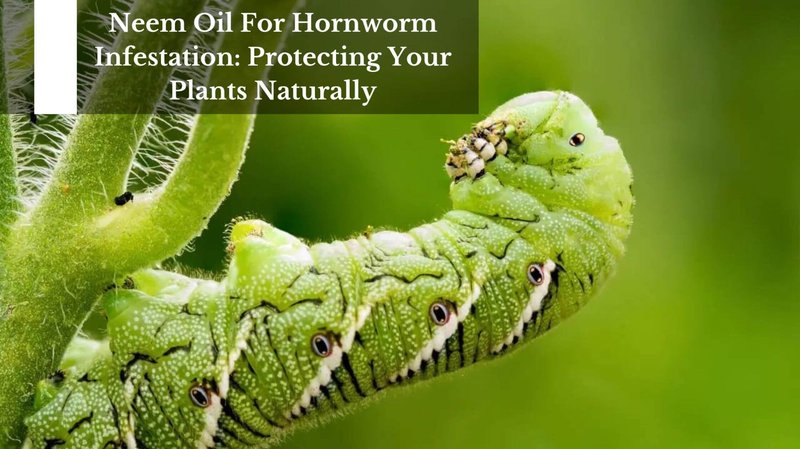
Neem oil isn’t just a garden trend; it’s been used for centuries in traditional medicine and agriculture. Extracted from the seeds of the neem tree, this oil boasts powerful insecticidal properties that can help you combat unwanted pests while keeping your plants healthy. It’s kind of like having a secret weapon in your garden toolkit!
In this article, we’ll explore how neem oil works against hornworm larvae, its benefits and drawbacks, and how to use it effectively. So, grab a cup of coffee and let’s dig in!
What Are Hornworm Larvae?
Hornworm larvae are the caterpillar stage of certain moths, primarily the tobacco hornworm and the tomato hornworm. They are notorious for their insatiable appetite, munching through leaves and fruit in your garden. You might be wondering why they’re called “hornworms”—it’s because they have a small horn-like projection on their rear, which gives them a unique appearance.
These larvae can grow quite large, reaching up to 4 inches long, and are typically bright green with white stripes. While they may seem harmless, don’t let their size fool you. Just a few of these little monsters can destroy a plant in no time. If you see droppings or frass around your plants, that’s typically a sign that hornworms are on the prowl.
How Neem Oil Works
Here’s the thing: neem oil isn’t a one-and-done solution. It works through a combination of methods to deter and control pest populations. When you apply neem oil to your plants, it disrupts the hornworm’s life cycle in a few key ways:
- Insect Growth Regulator: Neem oil contains compounds called azadirachtin, which can interfere with the growth and development of insects. This means it can prevent hornworms from maturing and reproducing.
- Repellent Properties: The strong smell of neem oil can deter hornworms from munching on your plants. To them, it’s like an unappetizing meal!
- Reduced Feeding: When hornworms ingest neem oil, it can cause them to stop feeding altogether, allowing your plants to recover.
So, why is this important? By using neem oil, you’re not just protecting your plants; you’re also avoiding harsh chemicals that can harm beneficial insects and the environment. It’s a win-win!
Benefits of Using Neem Oil
Using neem oil against hornworm larvae comes with several advantages that make it a go-to choice for many gardeners. Let’s break down some of these benefits:
1. Environmentally Friendly: Neem oil is derived from a tree and is biodegradable. It breaks down quickly in the environment, minimizing its impact.
2. Beneficial for Other Insects: Unlike many pesticides that kill everything in their path, neem oil is selective. It targets pests like hornworms without harming beneficial insects like bees and ladybugs.
3. Versatile Usage: Neem oil can be used on a variety of plants, not just vegetables. You can spray it on flowers, herbs, and even fruit trees, making it a versatile choice for any garden.
4. Natural Pest Control: It’s often considered a safer alternative to synthetic pesticides, meaning you can feel good about using it in your garden, especially if you’re growing food for yourself or your family.
Of course, it’s essential to understand that while neem oil can be effective, it may not eliminate hornworms entirely. Think of it as part of a broader integrated pest management strategy.
How to Apply Neem Oil
Applying neem oil is pretty straightforward, but there are a few best practices to ensure you get the most out of it. Here’s a simple step-by-step process to help you along:
1. Choose the Right Neem Oil: Look for a cold-pressed, organic neem oil, as it retains more of the beneficial compounds than refined versions.
2. Mix with Water: Typically, you’ll want to dilute neem oil with water. A general guideline is to mix about 2 tablespoons of neem oil with a gallon of water. You can add a few drops of liquid soap to help emulsify the oil, making it easier to mix.
3. Test First: Before applying it all over your garden, do a patch test. Spray a small area and wait 24 hours to see how your plants react.
4. Spray During Evening Hours: Neem oil works best when sprayed in the evening or early morning when temperatures are cooler. This helps to prevent the oil from evaporating too quickly and maximizes its effectiveness.
5. Repeat Regularly: To maintain control over hornworm populations, you might need to reapply neem oil every 7 to 14 days, especially after rain or watering.
Following these steps can help you harness the power of neem oil effectively. Just remember, consistency is key!
Potential Drawbacks of Neem Oil
While neem oil is indeed beneficial, it’s wise to be aware of some potential drawbacks. Here are a few things to keep in mind:
– Sensitivity in Certain Plants: Some plants might be sensitive to neem oil. Always test a small area first, as mentioned earlier, to avoid any unwanted damage.
– Timing is Everything: Neem oil is most effective on young hornworms. If the pests are already large, they may not be deterred as easily.
– Odor: Neem oil has a strong, earthy scent that some people find unpleasant. While it dissipates over time, it might be something to consider on your application days.
Understanding these factors can empower you to use neem oil thoughtfully and effectively.
Alternatives to Neem Oil
If neem oil doesn’t seem like the solution for you, or if you want to try something different, there are a few alternatives. Here are some other natural options:
- Soap Sprays: Insecticidal soap can kill soft-bodied insects like hornworms on contact. Mix a few drops of liquid soap with water and spray directly onto the pests.
- Diatomaceous Earth: This fine powder can be dusted on plants. It works by damaging the exoskeletons of insects, leading to dehydration.
- Handpicking: Sometimes the best option is manual removal—simply pick the hornworms off your plants. It’s a bit more labor-intensive but effective.
Choosing the right method depends on your gardening style and preferences. Sometimes a combination of strategies works best!
Using neem oil against hornworm larvae can be an effective and environmentally friendly solution for gardeners looking to protect their plants. By understanding how neem oil works, its benefits, and how to apply it correctly, you can tackle those pesky hornworms head-on. Remember to consider potential drawbacks and explore other alternatives if needed.
With a little diligence and the right tools in your garden arsenal, you’ll be on your way to healthier plants in no time. So, the next time you find those green caterpillars munching away, don’t panic—reach for that neem oil and let nature lend you a hand! Happy gardening!

